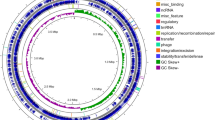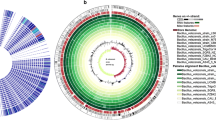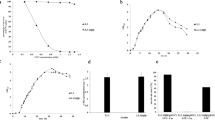Abstract
The aim of this work was to study phylogenetic relationships between the new producer strain Bacillus subtilis IFBG MK-2 and the existing strains and increase the biosynthetic activity of this producer by mutagenesis. As a result of sequencing the 16S rRNA gene of the IFBG MK-2 strain, gene fragments with a total length of 1305 nucleotides have been obtained. Based on the 16S rRNA gene nucleotide sequences, a phylogenetic analysis was performed and a dendrogram was constructed using the Neighbor Joining method and the Kimura two-parameter model. It has been shown that the similarity between the sum of the 16S rRNA gene sequenced fragments of the IFBG MK-2 strain and the GenBank-deposited sequence of this gene of the B. subtilis IAM 12118 type strain reaches 99%. Based on the phylogenetic analysis, the IFBG MK-2 strain was identified as B. subtilis. Through induced mutagenesis, using UV radiation and subsequent stepwise selection, a mutant clone B. subtilis IFBG MK-1A providing for a 50% increase in riboflavin production compared with the original strain has been obtained.




Similar content being viewed by others
REFERENCES
Abbas, C.A. and Sibirny, A.A., Genetic control of biosynthesis and transport of riboflavin and flavin nucleotides and construction of robust biotechnological producers, Microbiol. Mol. Biol. Rev., 2011. https://doi.org/10.1128/MMBR.00030-10
Amin, F.A.Z., Sabri, S., Ismail, M., et al., Probiotic properties of Bacillus strains isolated from stingless bee (Heterotrigona itama) honey collected across Malaysia, Int. J. Environ. Res. Public Health, 2020. https://doi.org/10.3390/ijerph17010278
Andriiash, G.S., Zabolotna, G.M., Bondarenko, V.S., et al., Gene 16s rRNA sequence phylogenetic analysis of lysine producers strains, Biotechnol. Acta, 2014. https://doi.org/10.15407/biotech7.06.040
Asia, L., Mohsin, I., and Muhammad, A., Ethyl methane sulfonate chemical mutagenesis of Bacillus subtilis for enhanced production of protease, Org. Med. Chem. Int. J., 2018. https://doi.org/10.19080/OMCIJ.2018.05.555664
Boretsky, Yu.R., Petryshyn, A., Krieger, K., et al., Cloning and expression of a gene encoding riboflavin synthase of yeast Pichia guilliermondii, Tsitol. Genet., 2002, vol. 36, no. 4, pp. 3–7.
Cortesгo, M. et al., Bacillus subtilis spore resistance to simulated Mars surface conditions, Front. Microbiol., 2019. https://doi.org/10.3389/fmicb.2019.00333
Debabov, V.G., The industrial use of Bacilli, in The Molecular Biology of the Bacilli, USA, New York, 1981, pp. 331–371.
Franco-Duarte, R. et al., Advances in chemical and biological methods to identify microorganisms—from past to present, Microorganisms, 2019. https://doi.org/10.3390/microorganisms7050130
Ge, Y.-Y. et al., Screening and spontaneous mutation of pickle-derived Lactobacillus plantarum with overproduction of riboflavin, related mechanism, and food application, Foods, 2020. https://doi.org/10.3390/foods9010088
Gershanovich, V.N. et al., Transketolase mutation in riboflavin-synthesizing strains of Bacillus subtilis, Mol. Gen. Mikrobiol. Virusol., 2000, vol. 3, pp. 3–7.
Gingichashvili, S., Duanis-Assaf, D., Shemesh, M., et al., The adaptive morphology of Bacillus subtilis biofilms: a defense mechanism against bacterial starvation, Microorganisms, 2020. https://doi.org/10.3390/microorganisms8010062
Karpov, D.S., Domashin, A.I., Kotlov, M.I., et al., Biotechnological potential of the Bacillus subtilis 20 strain, Mol. Biol., 2020. https://doi.org/10.1134/S0026893320010082
Lane, D.J., 16S/23S rRNA sequencing, in Nucleic Acid Techniques in Bacterial Systematics, Stackebrandt, E. and Goodfellow, M., Eds., New York: Wiley, 1991, pp. 115–175.
Liu, S., Hu, W., and Wang, Z., Production of riboflavin and related cofactors by biotechnological processes, Microb. Cell Fact., 2020. https://doi.org/10.1186/s12934-020-01302-7
Mohsin, I., Muhammad, A., and Fareeha, B., Development of Bacillus subtilis mutants for overproduction of protease, J. Microb. Biochem. Technol., 2017. https://doi.org/10.4172/1948-5948.1000363
Radchenko, M.M. et al., Isolation and identification of a strain producing riboflavin, Fakt. Eksp. Evol. Organiz., 2019. https://doi.org/10.7124/FEEO.v24.1094
Saleh, A.A., Dawood, M.M., Badawi, N.A., et al., Effect of supplemental serine-protease from Bacillus licheniformis on growth performance and physiological change of broiler chickens, J. Appl. Anim. Res., 2020. https://doi.org/1080/09712119.2020.1732986
Schallmey, M., Singh, A., and Ward, O.P., Developments in the use of Bacillus species for industrial production, Can. J. Microbiol., 2004. https://doi.org/10.1139/W03-076
Suwannasom, N., Kao, I., Pruẞ, A., et al., Riboflavin: the health benefits of a forgotten natural vitamin, Int. J. Mol. Sci., 2020. https://doi.org/10.3390/ijms21030950
Tamura, K., Stecher, G., and Peterson, D., MEGA6: molecular evolutionary genetics analysis version 6.0, Mol. Biol. Evol., 2013. https://doi.org/10.1093/molbev/mst197
Wang, J., Wang, W., Wang, H., et al., Improvement of stress tolerance and riboflavin production of Bacillus subtilis by introduction of heat shock proteins from thermophilic bacillus strains, Appl. Microbiol. Biotechnol., 2019. https://doi.org/10.1007/s00253-019-09788-x
Xue, F., Sampedro-Torres-Quevedo, C., Arnaouteli, S., et al., Probiotic Bacillus subtilis protects against a-synuclein aggregation in C. elegans, Cell Rep., 2020. https://doi.org/10.1016/j.celrep.2019.12.078
Zaghari, M., Sarani, P., and Hajati, H., Comparison of two probiotic preparations on growth performance, intestinal microbiota, nutrient digestibility and cytokine gene expression in broiler chickens, J. Appl. Anim. Res., 2020. 1080/09712119.2020.1754218
Zhang, C., Wu, D., and Ren, H., Economical production of vitamin K2 using crude glycerol from the by-product of biodiesel, Sci. Rep., 2020. https://doi.org/10.1038/s41598-020-62737-x
Funding
The study was supported by the Creation of Overproducer Strains for Secondary Metabolites (Amino Acids, Alcohols, and Vitamins) departmental program. State registration no. 0119U101489.
Author information
Authors and Affiliations
Corresponding author
Ethics declarations
The authors declare that they have no conflict of interests.
This article contains no results of any investigations involving humans and animals as their objects.
Additional information
Translated by N. Tarasyuk
About this article
Cite this article
Radchenko, M.M., Tigunova, O.O., Zelena, L.B. et al. Phylogenetic Analysis of the Bacillus subtilis IFBG MK-2 Strain and Riboflavin Production by Its Induced Clones. Cytol. Genet. 55, 145–151 (2021). https://doi.org/10.3103/S0095452721020134
Received:
Revised:
Accepted:
Published:
Issue Date:
DOI: https://doi.org/10.3103/S0095452721020134




